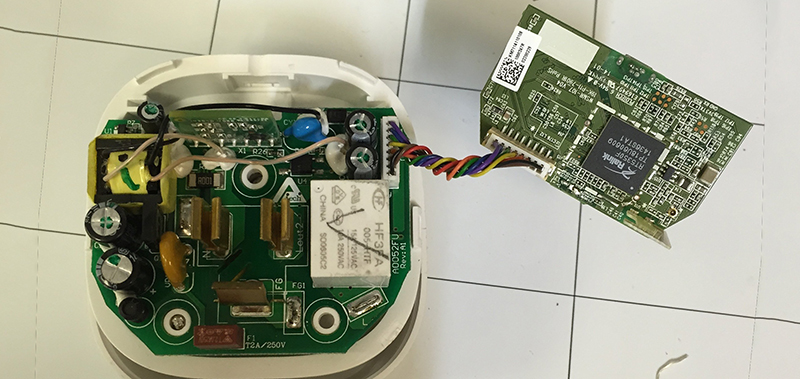Walk into any home improvement store, and you’ll find dozens of smart accessories, home automation equipment, and WiFi-connected ephemera. The Belkin WeMo Insight is one of these devices, giving anyone with $60 and a WiFi network the ability to switch lights and appliances on and off over a network. [John] picked up one of these WiFi plugs, but it didn’t work exactly as he would like. Instead of building a smart plug from scratch, [John] replaced the controller board for a WeMo Insight for his Hackaday Prize entry, making it far more useful and a replacement for devices like the Kill-a-Watt.
In its stock form, the WeMo can only be used though the smartphone app provided by Belkin or through a few third-party services like IFFT. All of these solutions have a limited API, and don’t provide advanced power metrics. To solve this problem, [John] replaced the smart controller board inside the Belkin WeMo with one of their own design.
By volume, most of the electronics inside the WeMo are a transformer, caps, and a relay; the smarts of this smart plug are just a daughterboard. By re-engineering this daughterboard with a new microcontroller, an ESP8266, and a microSD card connector, [John] can replicate the functionality of the WeMo while adding some new features. SD card datalogging for up to four years is now possible, a RTC now provides precise time stamps on all data collected, and a few simple calculations on the microcontroller enable power factor, line frequency, and total energy metering. With the ESP, all this data can be sent up to the cloud with a vastly improved API.
It’s a great project, and something that Belkin should seriously consider for their next revision of the WeMo. For anyone stuck with a stock WeMo, [John] has made all his design files and code available, allowing anyone to replicate this build
You can check out [John]’s Hackaday Prize entry video below.





















why not ‘simply’ reprogram RT5350, its FULLY supported in openwrt
A good point, maybe not enough RAM?
32 MB RAM, 16MB SPI Flash. Come on, the whole world fits in that :D
https://wikidevi.com/wiki/Belkin_WeMo_Insight_%28F7C029%29
That’s an interesting idea. My goal is to eventually build a full standalone plug so I went with a custom PCB but if you want to just “upgrade” the hardware you could try reprogramming the chip.
Super hardware integration and underlying coding. Impressive demo and video, which itself took time to put together. How accurate are the measurements available from the device?
Thanks! The measurements are all from the solid state meter (78M6610+PSU) which as a 24 bit “energy measurement processor (EMP)” Pretty nice precision.
But can it be configured so I am only using Solar power from the grid?
so the first picture shows an rt5350F, which has 2 100Mbit network interfaces, wifi bgn, i2c, i2s, 2 serial interfaces, etc…
and it got replaced with an esp 8266 module???
if it could actually do ESP and not just be a name, it would be AWESOME… but it isn’t so…
sorry for repeating another posters post….
Why didn’t he just reprogram it, it is (fully) supported in openwrt!!!!!
oh yeah, it also has USB, and gpio support… Damn, add some display, and the bloody thing can run doom!
Offcourse most of those interfaces require the correct hardware to hook it up, but hey, this is hackaday, you guys can figure something out, with a paperclip and some duct tape :-D
I remember being able to buy the thing for like $25 fully equipped, with dual nic, dual usb, connectors for all the interfaces and sound in/output. also, the vocore (i think) uses the same soc.
The only reason I would go his way, is because I know nothing about hardware programming in linux. and my honest opinion… programming for embedded devices in linux, seems like having to wade through an entire phonebook for every type of board, almost doesn’t matter which cpu or soc it uses. urgh.
apologies for the rant :)
Yep, the stock chip is pretty much overkill for the plug. Ditto for the power meter chip. Overall the design choices for this product are a little odd. My goal however is to build a custom smart plug and not use any commercial products. I’m using the WeMo enclosure and host board right now because they are solidly built and UL certified. If I get some $$ I’ll look into injection molding and certification.
I’m using the ESP because I like outsourcing the wireless stuff to a module. FCC certification is easier if you are using certified modules (…I know my current one isn’t) and any upgrades to protocol stacks, antenna design, etc. come for free by switching out the module. The code is designed to encapsulate the network stuff in wifi.c so changing to a different module shouldn’t affect the code too much.
Well, it might be overkill when almost none of the features it has are used, except for wifi and a gpio pin.
so why not go ahead, and add, usb, so you attach a webcam and some sound IO for surveillance, 2 nics to extend the range of the lan, a connector to attach more IO, like alarm toggles, switches, that way, you can have a remote activation, power usage, house alarm, baby monitoring system :)
Make sure the software tries to connect to a cloud system of your own, and voila, suddenly you are big brother… ;-)
This is cool, but wow that Wattsworth project really looks amazing. Wlil that be open source too?